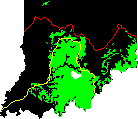Pleistocene Glaciations
During most of the last 1 billion years, the Earth had no permanent ice. But then, about 4 million years ago, the late Cenozoic ice age began. During an ice age, cyclic climate changes occur such that snowfalls do not completely melt the following summer. Ice sheets advance and retreat on temperate areas at intervals of about every 100,000 years. These shorter events are known as glaciations.  The last two glaciations severe enough to reach this part of the state were the Illinoian and the Wisconsinan. The Illinoian glaciation peaked ~220,000 years ago and its maximum southern extent is indicated by the yellow line at right. The Wisconsinan glaciation (red) peaked about 20,000 years ago.
The last two glaciations severe enough to reach this part of the state were the Illinoian and the Wisconsinan. The Illinoian glaciation peaked ~220,000 years ago and its maximum southern extent is indicated by the yellow line at right. The Wisconsinan glaciation (red) peaked about 20,000 years ago.
These glaciations had a major impact on Indiana geology. Glacial sediments buried much of the karst present in the older limestones north of these glacial boundaries. Today, this buried karst supplies an important groundwater source for much of northern and eastern Indiana. Glacial boundaries and their meltwaters also defined the current course of the Ohio, Wabash, Muscatatuk, White, and other major rivers in Indiana.
For various reasons, the Mitchell Plateau was mostly spared glaciation. The green areas of the map show current exposed bedrock areas in the state. Where this coincides with the Blue River and Sanders group limestones shown in the previous slide, karst terrain displays its most extensive development.